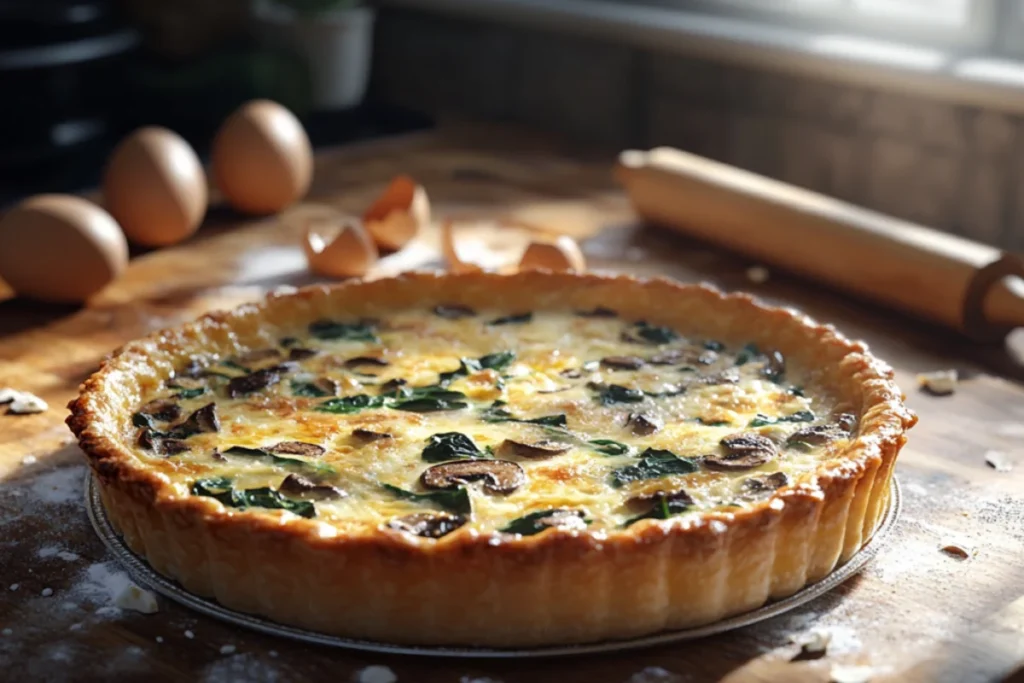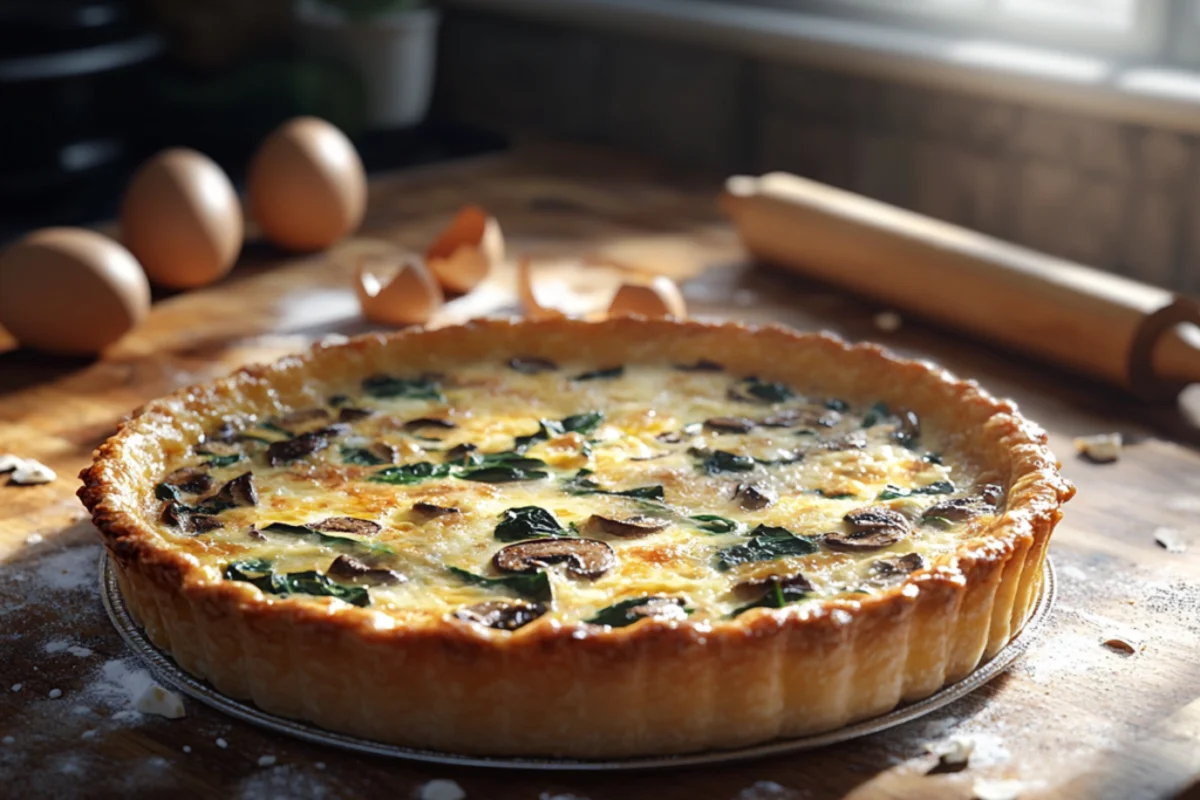
What is the Irresistible Difference Between a Quiche and a Breakfast Casserole? The answer lies in their construction, purpose, and the specific flavors they deliver. While both are egg-based dishes often enjoyed at brunch or breakfast, their textures, ingredients, and preparation methods create distinct culinary experiences. Understanding these differences unlocks a deeper appreciation for both dishes and allows you to choose the perfect option for your next gathering.
What is the Irresistible Difference Between a Quiche and a Breakfast Casserole? A Detailed Comparison
Quiche and breakfast casserole, though both popular choices for a morning meal, offer quite different flavor profiles and textures. A quiche is known for its creamy, custard-like filling baked in a pastry crust, while a breakfast casserole generally features a more substantial base of bread, potatoes, or other hearty ingredients.
The Crust Factor: A Fundamental Difference
The most obvious difference lies in the crust. A quiche must have a crust, typically made from a rich, buttery pastry. This crust provides structure and a buttery flavor that complements the egg filling. A breakfast casserole, however, rarely includes a crust. It is usually baked in a baking dish without any pastry.
The Filling Composition: Eggs and More
Both quiche and breakfast casseroles rely on eggs as a binding ingredient. However, the ratio of eggs to other ingredients differs significantly. Quiche emphasizes the creamy egg custard, often featuring cream or milk in a higher proportion. Breakfast casseroles use eggs to bind together other ingredients like sausage, cheese, vegetables, and bread.
Purpose and Occasion: Setting the Table
Quiche is often considered a more elegant dish, suitable for brunches, luncheons, or even light dinners. Its refined presentation and creamy texture make it a sophisticated choice. Breakfast casseroles, on the other hand, are generally seen as a more casual and hearty option, perfect for feeding a crowd during weekend breakfasts or holidays.
Deconstructing the Quiche: A French Classic
The quiche, originating from the Lorraine region of France, has become a beloved dish worldwide. Its versatility lies in the endless variations possible with its filling.
Classic Quiche Lorraine: The Foundation
The most traditional quiche is Quiche Lorraine, featuring eggs, cream, bacon (or lardons), and sometimes Gruyère cheese. This simple combination highlights the rich flavors of the ingredients and the creamy texture of the custard. This classic is difficult to beat.
Beyond the Basics: Flavorful Variations
From vegetable-packed quiches to seafood variations, the possibilities are endless. Spinach and mushroom quiche, asparagus and Gruyère quiche, and smoked salmon quiche are just a few popular examples. The filling can be adapted to seasonal ingredients and personal preferences.
Baking the Perfect Quiche: A Delicate Balance
Achieving the perfect quiche requires careful attention to detail. Blind baking the crust before adding the filling prevents a soggy bottom. Using high-quality ingredients ensures a flavorful and creamy result. Baking the quiche slowly at a moderate temperature allows the custard to set evenly without curdling.
Exploring the Breakfast Casserole: A Hearty Morning Meal

The breakfast casserole offers a more rustic and comforting approach to breakfast. Its customizable nature and ability to feed a large group make it a popular choice for family gatherings.
The Foundation: Bread, Potatoes, or Hash Browns
The base of a breakfast casserole typically consists of bread, potatoes, or hash browns. These ingredients soak up the egg mixture and provide a hearty foundation for the other fillings. Day-old bread works especially well, as it absorbs the liquid without becoming too soggy.
Protein Power: Sausage, Bacon, or Ham
Adding protein to a breakfast casserole elevates it to a satisfying and filling meal. Sausage, bacon, ham, or even leftover cooked chicken or turkey can be used. The protein is often browned before being added to the casserole to enhance its flavor.
Cheese, Vegetables, and Seasoning: The Final Touches
Cheese adds richness and flavor to a breakfast casserole, while vegetables provide nutrients and texture. Cheddar, mozzarella, Monterey Jack, and pepper jack are all popular choices. Onions, peppers, mushrooms, spinach, and tomatoes are common vegetable additions. Seasoning is key to bringing all the flavors together.
Assembling and Baking the Casserole: A Simple Process
Assembling a breakfast casserole is a straightforward process. The base ingredients are layered in a baking dish, followed by the protein, vegetables, and cheese. The egg mixture is then poured over the top, ensuring that all the ingredients are well coated. The casserole is baked until the eggs are set and the top is golden brown.
Texture and Taste: Key Differentiators
The texture and taste of quiche and breakfast casserole differ greatly. The smooth, creamy texture of quiche contrasts with the often more chunky and varied textures of a casserole.
Creamy Custard vs. Hearty Layers
The defining characteristic of a quiche is its creamy, custard-like filling. The eggs and cream combine to create a smooth and decadent texture that melts in your mouth. Breakfast casseroles, on the other hand, feature a more layered texture, with the distinct flavors and textures of the bread, protein, vegetables, and cheese coming together in each bite.
Subtle Elegance vs. Bold Flavors
Quiche often boasts a more subtle and elegant flavor profile. The richness of the cream and eggs is balanced by the delicate flavors of the other ingredients. Breakfast casseroles tend to be bolder in flavor, with the savory notes of sausage, bacon, and cheese dominating the palate.
Serving and Presentation: Visual Appeal
The way a dish is served and presented also contributes to the overall dining experience. Quiche is often sliced into wedges and served warm or at room temperature. Breakfast casseroles are typically served straight from the baking dish, often accompanied by a side of fruit or yogurt.
Elegant Slices vs. Rustic Portions
Quiche is typically presented as elegant slices, showcasing the creamy filling and golden-brown crust. The uniform texture and clean presentation make it an appealing dish for formal occasions. Breakfast casseroles are often served in more rustic portions, reflecting their casual and comforting nature.
Garnishes and Accompaniments: Completing the Meal
Garnishing quiche with fresh herbs or a sprinkle of paprika adds visual appeal and enhances its flavor. Breakfast casseroles can be garnished with chopped green onions, shredded cheese, or a dollop of sour cream. Both dishes can be accompanied by a variety of sides, such as fruit salad, yogurt, or a simple green salad.
Image Placeholder: alt text “Irresistible Quiche and Breakfast Casserole Comparison”
Nutritional Considerations: A Healthier Choice?

While both quiche and breakfast casseroles can be part of a balanced diet, it’s important to consider their nutritional content.
Calorie Count and Fat Content: A Balancing Act
Quiche, with its rich pastry crust and creamy filling, tends to be higher in calories and fat than breakfast casseroles. Breakfast casseroles, depending on the ingredients used, can be a healthier option, especially when made with whole-grain bread, lean protein, and plenty of vegetables.
Protein and Carbohydrates: Fueling the Body
Both quiche and breakfast casseroles are good sources of protein, which is essential for building and repairing tissues. Breakfast casseroles often provide more carbohydrates, thanks to the bread or potatoes, providing sustained energy throughout the morning.
Sodium and Cholesterol: Moderation is Key
Both quiche and breakfast casseroles can be high in sodium and cholesterol, depending on the ingredients used. Choosing lower-sodium ingredients and limiting the amount of cheese and processed meats can help reduce the sodium and cholesterol content. It’s always best to enjoy these dishes in moderation as part of a well-rounded diet.
Image Placeholder: alt text “Nutritional comparison of quiche and breakfast casserole ingredients”
Recipe Adaptations: Making it Your Own
One of the best things about both quiche and breakfast casseroles is their adaptability. With a few simple tweaks, you can create dishes that perfectly suit your taste and dietary needs.
Vegetarian Options: Embracing Plant-Based Ingredients
For vegetarians, quiche and breakfast casseroles offer endless possibilities. Tofu, tempeh, or seitan can be used in place of meat, while vegetables like spinach, mushrooms, and asparagus add flavor and nutrients. Using a store-bought or homemade vegan crust is important for a completely vegetarian quiche.
Gluten-Free Alternatives: Catering to Dietary Restrictions
Individuals with gluten sensitivities or celiac disease can enjoy quiche and breakfast casseroles by using gluten-free ingredients. Gluten-free crusts are readily available in most supermarkets, while gluten-free bread or potatoes can be used in breakfast casseroles. It’s important to carefully check the labels of all ingredients to ensure they are gluten-free.
Low-Fat Variations: Lighter and Healthier
Reducing the fat content of quiche and breakfast casseroles is possible by making a few simple substitutions. Using low-fat milk or Greek yogurt in place of cream, reducing the amount of cheese, and opting for lean protein sources can significantly lower the fat content.
Image Placeholder: alt text “A delicious and healthy vegetarian quiche with vibrant vegetables”
Choosing the Right Dish: A Matter of Preference
Ultimately, the choice between quiche and breakfast casserole comes down to personal preference and the occasion. Quiche is a sophisticated and elegant option, while breakfast casserole offers a more casual and comforting experience.
For Elegant Brunches: Quiche is the Star
If you’re hosting an elegant brunch or luncheon, quiche is the perfect choice. Its refined presentation and creamy texture make it a sophisticated and crowd-pleasing dish. Pair it with a crisp green salad and a glass of sparkling wine for a truly memorable meal.
For Casual Gatherings: Casserole Comfort
For casual gatherings, such as family weekend breakfasts or holiday brunches, breakfast casserole is the ideal option. Its hearty and comforting nature makes it a perfect dish for sharing with loved ones. Serve it with fresh fruit, yogurt, and a side of toast for a complete and satisfying meal.
Considering Dietary Needs and Preferences
When choosing between quiche and breakfast casserole, it’s important to consider the dietary needs and preferences of your guests. Offering both vegetarian and gluten-free options ensures that everyone can enjoy the meal. Ultimately, selecting the dish that best suits the occasion and the preferences of your guests will guarantee a successful and enjoyable dining experience.
Image Placeholder: alt text “A happy group of friends enjoying a brunch with quiche and breakfast casserole”
FAQ
What is the difference between quiche and breakfast casserole?
Quiche is a savory egg custard baked in a pastry crust, known for its creamy texture and elegant presentation. A breakfast casserole is a heartier dish, typically baked without a crust, and includes layers of ingredients like bread, potatoes, meat, and cheese bound together by eggs.
What is the difference between quiche and F?
This question is incomplete and doesn’t provide enough information to answer accurately. Please clarify the second item being compared to quiche.
What is the difference between a quiche and a pie dish?
A quiche and a pie dish are not inherently different things. A quiche is a specific type of dish prepared in a pie dish. The main difference lies in the filling: a quiche has a savory custard filling, while a pie can have sweet or savory fillings and doesn’t always include eggs.
What’s the difference between a quiche and an omelette?
A quiche is baked in the oven, while an omelette is cooked on the stovetop. A quiche contains a custard-like mixture of eggs and cream, while an omelette typically consists of eggs alone or with a small amount of liquid. Quiches are often more substantial and can feed multiple people, while omelettes are usually made for one person.

